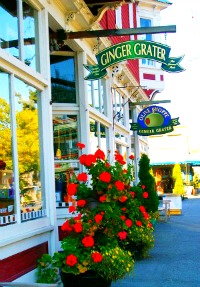In fantasy fiction/sci-fi small town settings, consider these social layers to make your characters' interactions believable
Copyright National Lilac Publishing, LLC

Whether your small town setting is low fantasy (Forks, Washington, USA Twilight) or high fantasy (Hobbiton, Lord of the Rings), small towns from fantasy earths to galactic worlds operate under familiar (yet sometimes invisible to the normal human observer) social layers. If your fantasy novel purposely dismisses this endearing trait among social creatures who gather to live amidst each others' company, at least know the rules you're breaking. And remember that fantasy worlds may come from the edges of imagination, but many readers don't want basics, such as heroism, romance, the individual's need for autonomy balanced with familiar social community dynamics to be dropped from the interweavings of the story.
There are countless ways for two strangers to meet briefly -- such as a quick exchange of words or covert passing of secret codes -- then they're both off on their way. But here, we're dealing with instances where a character, strange to a small town, must embed himself into the community's hidden social depths in order for an important step in the plot to occur.
Your small-town character needs to meet a newcomer -- a stranger in town -- and ignite a strong enough bond that lasts through a significant part of your story.
Or, your character is the stranger in town -- the newcomer himself in town -- and the plot calls for him to either establish a deep, trusting, lasting bond with another as yet unknown secondary character who is established in town, or even discover a group of people entrenched in the town who will play a significant role in the story.
We want to avoid, “Jaida chose a restaurant in the town he’d never been to before and strolled in seeing a place full of strangers. One of them instantly greeted Jaida and became his perfect best buddy sidekick after a five minute conversation, and invited him to join a covert group in town that was secretly plotting against the government, which happened to be meeting that very night -- which turned out to be exactly what Jaida needed to move along on his adventure.”
Small towns, instead, tend to have “community within the community” -- the private invitation only unadvertised get-togethers that unknown newcomers usually can’t immediately penetrate. The town’s social scene can be looked at as having three layers of community -- with the first two layers being easier for newcomers to plug into, and the final third -- that community within the community -- the toughest one. Once these layers are understood, it can be easier for the newcomer in your story to eventually more believably plug in like a local.
Here are three social levels of small towns: Take note of these especially if your character either moves into a new small town, or is a small town embedded local and has to deal with a different new character coming through town.
The first layer of community in a small town consists of the places and events any unknown newcomer can find just by driving through town or reading the newspaper or the town’s online site. It consists of places and events where newcomers are expected, even solicited. For example, the town’s hotel. Restaurants and pubs on Main Street. The town’s church. Festivals the town hopes to encourage outsiders to come to, such as a small rural community’s autumn pumpkin festival they advertise to more distant larger cities, or a small town’s spring break carnival they hope other nearby town citizens will show up at. Though the town’s regulars take part in these places and events, it isn’t such a shock when unknowns show up at these as well. Newcomers and visiting tourists can bring revenue to the community, so it’s often hoped they’ll show up. Or as with churches, many are always looking for new converts and members.
A completely unknown newcomer can certainly meet established town citizens at these places and quickly merge into a strong relationship with them.. But once you understand the other two layers discussed below, you may see why it can be less believable that trustworthy bonds (vs. simply the first quick meeting) would establish at this level. And too often in fiction, this is where authors have unknown newcomers and long-time citizens quickly fall into deep relationships that most small townspeople are too guarded to allow right away.
For example, the female teenage protagonist is passing through a previously unknown town with her parents who plan to move to that town soon. She ends up at the town’s fiddle festival because her parents spontaneously pulled over to watch it for a few moments. Within minutes, the perfect new teen best friend appears and strikes up conversation with this teenage stranger. And by the next paragraph, the teen protagonist is accepted as a member of the exclusive alpha teenage clique who invite her to all their private get-togethers. Sure it happens. But it can be hard to swallow. It’s far harder to plug in to the private get-togethers from this first layer.
Consider the second layer of community instead: Second layer gatherings tend to be announced or advertised more just to the locals, although they don't purposely exclude outsiders. Town hall meetings. PTA meetings. Weekly poetry readings at the public library that are announced by a flier on the library bulletin board seen by current patrons. A new men’s Saturday night basketball open drop-in announced to those who already reside there and therefore get the town’s Parks and Recreation newsletter automatically sent to their address.
All
layers overlap of course, but those that seem more second-layer-type
are usually more intimate and they repeat often. People are sitting or
acting closer together naturally and in smaller groups, so they don’t
have to find excuses to approach a stranger at a large one-time event to
make conversation. Since they repeat at close time intervals (vs. a
first layer event like an annual town rodeo or music festival), each
interaction can substantially build on the previous ones. The new yoga
student in the local weekly yoga class
notices another student who seems quiet like she is. She wonders if she
might be open to friendship. She says a brief hello with eye contact.
The next class, she puts her mat next to this
person. Conversations build from the previous week’s interaction. They
start walking together after class. Eventually, the newcomer is invited
by the established townsperson to a private third layer (see below)
event or location the newcomer otherwise could never have found on her
own.
As mentioned, though aimed at locals, the second layer events and venues are still those that anyone is allowed to join in. Your main character can still find these places and events even though brand new to town, she just may need to search a bit deeper (such driving through town and finding a restaurant (a first level location), then reading a Parks & Recreation newsletter a local left behind, announcing the yoga classes).
Because of their intimacy and repetitiveness, unlike first level events, second layers can be bridges to the deepest level of a community, the guarded third layer that’s by private invitation only. It gives time for the newcomer to become trusted and understood, and therefore handed a key to the third level.
The keys to your character reaching the third layers of a community are private invitations by those already considered accepted. Invites are the only way newcomers are allowed. Humans are tribal by nature, and our instincts are that some human outsiders can’t be trusted, might be disruptive or take a group off course, or would reveal information a group doesn’t want revealed. Barriers must first be melted before unknowns can join. These “tribes” might include local secret societies, small book reading groups that gather with chosen invited close friends only, tight-knit teenage cliques, specialized think tanks, old-boys’ networks, a weekly tea shop meeting amongst close friends or a group of male friends who go fishing one Saturday a month. Once again, these aren’t advertised anywhere to the public, and are by invitation only.
It’s smoother and more natural for newcomers to town to be invited into third layer community from second layer, rather than going straight from first layer to third layer. Consider whether it’s appropriate for your two strangers (or stranger and unknown private group) to meet via a second layer activity or location vs. a first level.
Naturally, in your novel, you may need to save time. You don't want your character to take the time to find a second layer event or location. So a quick first layer to third layer new relationship helps the story avoid dragging on. Here are five thoughts on that.
1. The one newcomer/established citizen connection that can believably go from first layer to third layer is the romantic meeting. With male “searching and pursuit” energy, it isn’t that unusual for him to see a stranger he’s attracted to, then push his way into the newcomer’s world, bypassing any of the trust building steps the second layer can offer. If he plays it well, he can find out how to meet her again in a way that doesn’t seem threatening, such as meeting her for coffee without expecting her to give him her new phone and address. He can then gently create a facsimile of a second layer by setting up repetitive ways to meet that don’t call for commitment, allowing her to eventually trust him. For example, he himself could invite her to a second level event she hadn’t yet become aware of such as a weekly town volunteer project where they naturally work side by side without a constant hunt and chase going on.
2. In a first level meeting between romantics, if both are feeling the sudden hormones of infatuation… then screw the second level. They’ll rush together without it. Floods of oxytocin provide false senses of trust and belonging that bypass any need for trust building. This is believable. It happens all the time in the real world. Not that it isn’t overdone in fiction.
3. Without romance bypassing the tribal protection layer, the protagonist could possibly be invited directly into a third level invite-only connection by an insider he knew from his previous location -- such as a cousin he grew up with who now lives in this town and is involved in an insiders’ group who tells him he’s welcome to show up.
4. There can also be an emergency or danger that forces the newcomer to have to trust an unknown townsperson quickly. For example, your protagonist newcomer is knocked over and injured, and a bystanding stranger helps her to safety, quickly forging a close relationship without the usual trust-building steps. In this case, the emergency has to be that which the protagonist ordinarily wouldn’t have trusted such a stranger, but had no other choice. Though doable, this is vastly overdone in fiction in particular when the male rescues the female. She inevitably trips and falls while trying to run away from a danger and he rushes in to get her back on her feet or carry her to safety. It continues to exaggerate and become old-story and eye-rolling especially to females when the rescuing action he takes instantly makes her subservient to him, blindly trusting and faithful, and in awe of his powers. Even as a child when some of us were watching fantasy and other fiction movies, as soon as the desirable female showed up but wasn’t under the male hero's spell yet, we’d state, “Okay, any minute now she’s going to trip and fall he’ll have to rescue her.” She always did. He always did.
5. Could be it’s fantasy magic itself that allows the main character to bypass the usual levels of trust building. Such as the fantasy fiction protagonist is being led or guided in some way by a Serendipity entity. Perhaps she somehow gets an inner prompt whose source will be revealed later that the author wants to just hint at now. Or, he gets a signal from an elusive wizard’s voice or angel to stop off at a particular pub because an important meeting with someone he as yet doesn’t know will take place. That can be an excuse for such meetings to reach success so quickly. To make it a bit more believable (although this trick is also somewhat overdone in fiction), the character can protest within himself… “I hate pubs. Why am I getting signals to stop by this particular pub?”
In summary, remember that first layer meetings that instantly lead to exclusive third level relationships aren’t the norm in human society. More has to happen first for that bond to believably take place. Such bonds between strangers are more believable and can occur quicker in the second layer of a small town’s social network.






